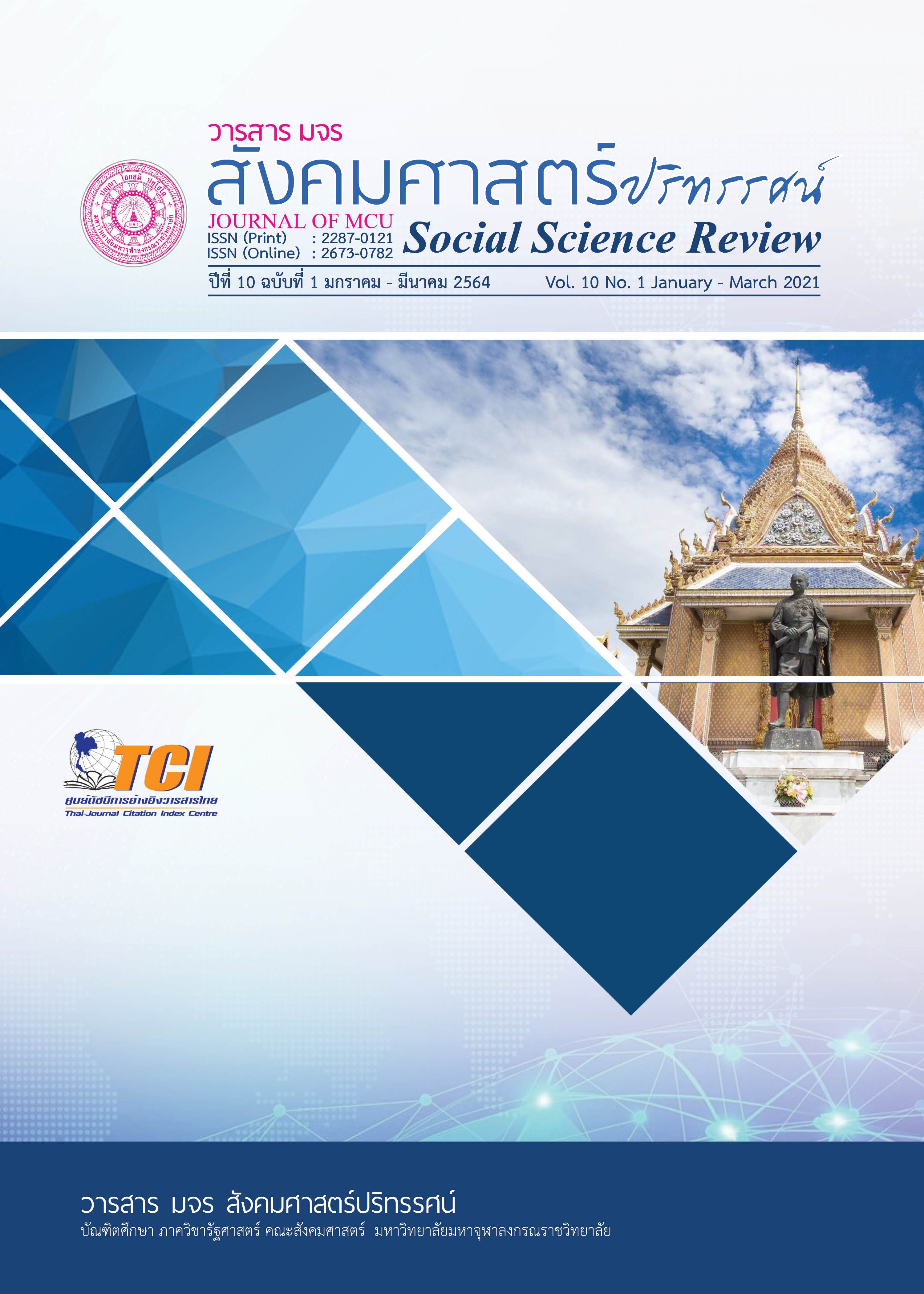การประยุกต์หลักพุทธธรรมเพื่อเป็นแนวทางการรับมือปัญหา โรคระบาด COVID-19
คำสำคัญ:
การประยุกต์หลักพุทธธรรม, แนวทางการรับมือปัญหา, โรคระบาดโควิค 19บทคัดย่อ
บทความวิชาการนี้นำเสนอแนวทางการรับมือตามหลักสากลและตามนโยบายของรัฐบาลโดยบูรณาการหลักพุทธธรรม คือ อริยมรรคมีองค์ 8 ได้แก่ 1. สัมมาทิฏฐิ คือ สร้างความตระหนักให้ประชาชนในชุมชนให้เฝ้าระวังการแพร่ระบาด 2. สัมมาสังกัปปะ คือ เตรียมความพร้อมของบุคลากรให้มีความเข้าใจในแผน 3. สัมมาวาจา คือ แจ้งเตือนสถานการณ์โรคติดต่อเชื้อไวรัส COVID-19 เพื่อให้ประชาชนรับรู้ข้อมูลข่าวสารที่เป็นจริง 4. สัมมากัมมันตะ คือ การทำกิจกรรมต่างๆ ช่วยเหลือเยียวยาด้วยความเต็มใจอย่างเต็มความสามารถ 5. สัมมาอาชีวะ คือ ส่งเสริมให้ประชาชน/กลุ่มเสี่ยง สามารถดำเนินชีวิตได้อย่างปกติสุข 6. สัมมาวายามะ คือ การสร้างการมีส่วนร่วมในการบูรณะปรับปรุง 7. สัมมาสติ คือ การสร้างขวัญกำลังใจแก่ประชาชน ช่วยเหลือเยียวยาจิตใจกลุ่มผู้ป่วยผู้เสียชีวิต ครอบครัวและประชาชนที่ได้รับผลกระทบ 8. สัมมาสมาธิ คือ การบูรณาการแผนงานตามมาตรการป้องกันและแก้ไขและประสานงานกับหน่วยงานที่เกี่ยวข้องเพื่อเตรียมความพร้อมต่อการรับมือในอนาคต สามารถนำมาบูรณาประยุกต์ใช้กับศาสตร์สมัยใหม่ได้อย่างลงตัว สร้างความเข้ารู้ความเข้าใจในวิถีของความเป็นเมืองพุทธ เป็นหลักการปฏิบัติทั้ง 3 ประการ ที่สามารถย่อให้เข้าใจได้ง่าย ได้แก่ 1) สนใจ ติดตามสถานการณ์การเปลี่ยนแปลงความรู้ใหม่ 2) เข้าใจ และปฏิบัติอย่างเหมาะสม 3) ดูแลตนเองและช่วยเหลือสังคม ที่เป็นความรอบรู้ รอบคอบและคำนึงถึงคนรอบข้าง
เอกสารอ้างอิง
กรมควบคุมโรค. (2563). โรคติดเชื้อไวรัสโคโรนา 2019 (COVID 19). สืบค้น 25 สิงหาคม 2563, จาก https://ddc.moph.go.th/
ฐานเศรษฐกิจ. (2563). ผลกระทบโควิค-มาตรการล็อกดาาวน์. สืบค้น 27 สิงหาคม 2563, จาก https://www.thansettakij.com/content/money_market/437244
มหาจุฬาลงกรณราชวิทยาลัย. (2539). พระไตรปิฎกภาษาไทย ฉบับมหาจุฬาลงกรณราชวิทยาลัย. กรุงเทพฯ: โรงพิมพ์มหาจุฬาลงกรณราชวิทยาลัย.
สมประวิณ มันประเสริฐ. (2563). ผลกระทบของโรคระบาดโควิค-19 ต่อเศรษฐกิจไทย. สืบค้น 27 สิงหาคม 2563, จาก https://www.krungsri.com/bank/th/plearn-plearn/economic-covid-impact.htm
สำนักข่าวแห่งชาติ กรมประชาสัมพันธ์. (2563). สถานการณ์การแพร่ระบาดของโรค COVID-19. สืบค้น 26 สิงหาคม 2563, จาก http://thainews.prd.go.th
สำนักงานคณะกรรมการสุขภาพแห่งชาติ (สช.). (2563). แนวทางการจัดวงปรึกษาหารือรวมพลังพลเมืองตื่นรู้ ช่วยชาติ สู้ภัย COVID-19 ระยะฟื้นฟูคุณภาพชีวิต. สืบค้น 26 สิงหาคม 2563, จาก http://www.nakhonpathom.go.th/
World Health Organization. (2020). Coronavirus disease (COVID-19) pandemic. Retrieved June 25, 2020, from https://www.who.int/emergencies/diseases/novel-coronavirus-2019
ดาวน์โหลด
เผยแพร่แล้ว
รูปแบบการอ้างอิง
ฉบับ
ประเภทบทความ
สัญญาอนุญาต
ลิขสิทธิ์ (c) 2021 วารสาร มจร สังคมศาสตร์ปริทรรศน์

อนุญาตภายใต้เงื่อนไข Creative Commons Attribution-NonCommercial-NoDerivatives 4.0 International License.
เพื่อให้เป็นไปตามกฎหมายลิขสิทธิ์ ผู้นิพนธ์ทุกท่านต้องลงลายมือชื่อในแบบฟอร์มใบมอบลิขสิทธิ์บทความให้แก่วารสารฯ พร้อมกับบทความต้นฉบับที่ได้แก้ไขครั้งสุดท้าย นอกจากนี้ ผู้นิพนธ์ทุกท่านต้องยืนยันว่าบทความต้นฉบับที่ส่งมาตีพิมพ์นั้น ได้ส่งมาตีพิมพ์เฉพาะในวารสาร มจร สังคมศาสตร์ปริทรรศน์ เพียงแห่งเดียวเท่านั้น หากมีการใช้ภาพหรือตารางหรือเนื้อหาอื่นๆ ของผู้นิพนธ์อื่นที่ปรากฏในสิ่งตีพิมพ์อื่นมาแล้ว ผู้นิพนธ์ต้องขออนุญาตเจ้าของลิขสิทธิ์ก่อน พร้อมทั้งแสดงหนังสือที่ได้รับการยินยอมต่อบรรณาธิการ ก่อนที่บทความจะได้รับการตีพิมพ์ หากไม่เป็นไปตามข้อกำหนดเบื้องต้น ทางวารสารจะถอดบทความของท่านออกโดยไม่มีข้อยกเว้นใดๆ ทั้งสิ้น





